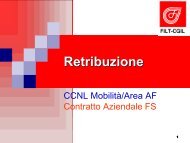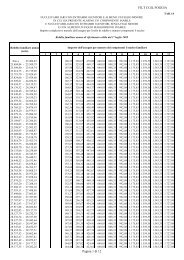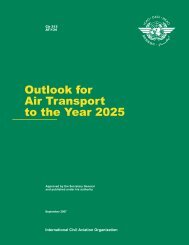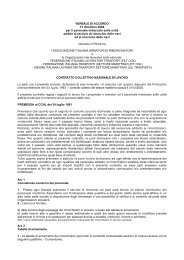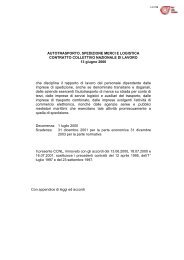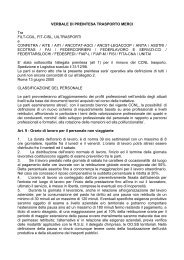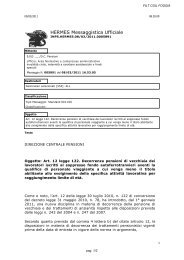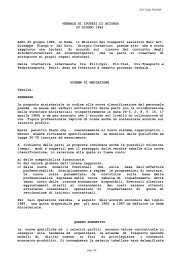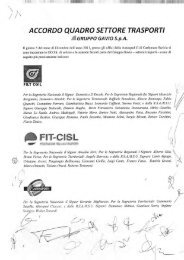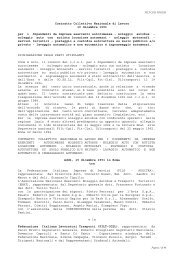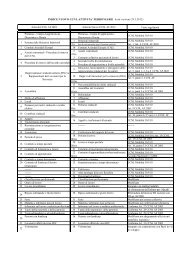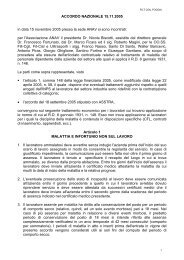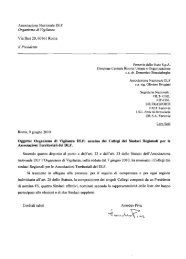Outlook for Air Transport to the Year 2015 - FILT CGIL Foggia
Outlook for Air Transport to the Year 2015 - FILT CGIL Foggia
Outlook for Air Transport to the Year 2015 - FILT CGIL Foggia
You also want an ePaper? Increase the reach of your titles
YUMPU automatically turns print PDFs into web optimized ePapers that Google loves.
Chapter 2AIR TRANSPORT TRENDS AND CHALLENGESECONOMIC DEVELOPMENT AND AIRLINE TRAFFIC PATTERNS1. From a long-term his<strong>to</strong>rical perspective, air transport has experienced greater growth than most o<strong>the</strong>rindustries. Since 1960, increasing demand <strong>for</strong> passenger and freight services, rapid technological developmentand associated investment have combined <strong>to</strong> multiply <strong>the</strong> output of <strong>the</strong> air transport industry by a fac<strong>to</strong>r of nearly30 in terms of TKPs. This expansion of air transport compares favourably with <strong>the</strong> broadest available measure ofworld output, <strong>the</strong> global GDP, which when measured in real terms has multiplied by 4 times over <strong>the</strong> same period.2. Economic <strong>the</strong>ory and analytical studies indicate that <strong>the</strong>re is a high correlation between <strong>the</strong> growthpatterns of air traffic and economic trends in that <strong>the</strong> demand <strong>for</strong> air transport is primarily driven by economicdevelopment. Developments in personal income affect <strong>the</strong> level of consumer purchasing power and <strong>the</strong>propensity <strong>to</strong> undertake leisure travel. Commercial activity and trade have a direct impact on <strong>the</strong> demand <strong>for</strong>business travel and <strong>for</strong> air freight. Figure 2-1 provides evidence of <strong>the</strong> relationship between <strong>the</strong> strength of <strong>the</strong>economy and traffic demand by illustrating <strong>the</strong> fluctuations in <strong>the</strong> rate of growth of each <strong>for</strong> <strong>the</strong> period 1960 <strong>to</strong><strong>the</strong> present. The impact of economic slowdowns and recessions on air traffic trends is clearly visible during <strong>the</strong>following years or periods: 1974–75, 1980–82, 1990–91, 1998 and 2001 (<strong>the</strong> latter coupled with <strong>the</strong>unprecedented events of 11 September).3. Between 1992 and 2002, worldwide scheduled traffic, measured in TKPs, grew at an average annual rateof 4.9 per cent, compared <strong>to</strong> a 3.0 per cent GDP growth. While <strong>the</strong> pattern of traffic growth over that period wasgenerally a reflection of economic conditions, <strong>the</strong> impact of recent event-related developments on air traveldemand (events of 11 September 2001, war in Iraq and <strong>the</strong> SARS outbreak) indicate that <strong>the</strong> air transport industryis sensitive <strong>to</strong> safety and security concerns and so-called fear and hassle fac<strong>to</strong>rs which influence consumerconfidence.4. O<strong>the</strong>r fac<strong>to</strong>rs that have affected traffic demand include airline costs, and hence fares and rates, regula<strong>to</strong>rydevelopments and <strong>the</strong> access <strong>to</strong> air and <strong>to</strong>urism services. Rapid growth in <strong>the</strong> 1960s coincided with <strong>the</strong>replacement of pis<strong>to</strong>n-engine aircraft with jet aircraft which led <strong>to</strong> reduced real fares and increased speed andcom<strong>for</strong>t of travel. In addition <strong>to</strong> an adverse effect on <strong>the</strong> world economy, sharp changes in <strong>the</strong> price of oil andaviation fuel (such as in 1973–1974 and fur<strong>the</strong>r escalation during 1979–1981) have had important effects onairline costs.TRENDS IN SCHEDULED PASSENGER, FREIGHT AND MAIL TRAFFIC5. Over <strong>the</strong> decades, <strong>the</strong> growth experienced by <strong>the</strong> <strong>to</strong>tal demand <strong>for</strong> air transport has been shared <strong>to</strong> avarying extent by each of its major components — passenger, freight and mail traffic. The average growth rate <strong>for</strong>each of <strong>the</strong>se components has declined since <strong>the</strong> 1960s as shown in Table 2-1. The gradual decline in mail traffichas been particularly severe, partly because of increasing competition from telecommunications.5




